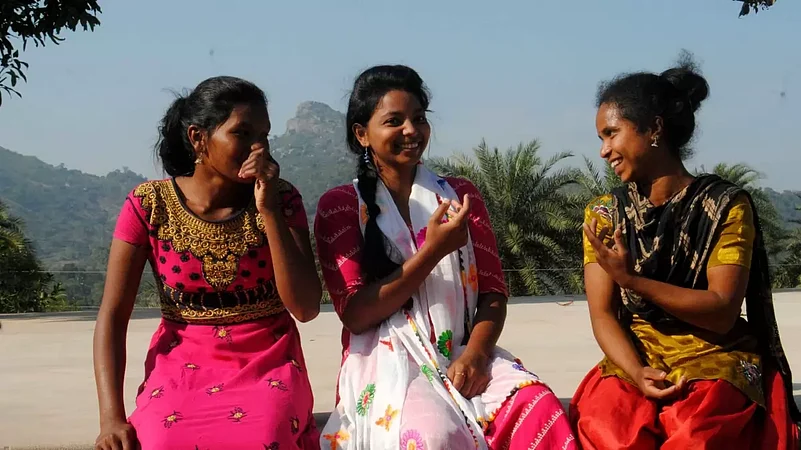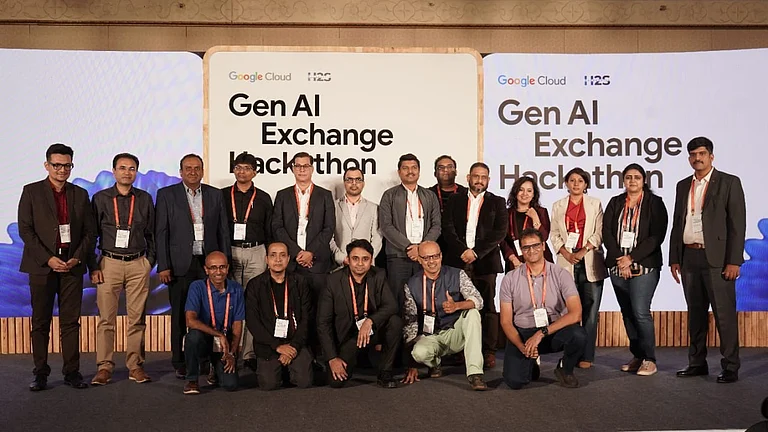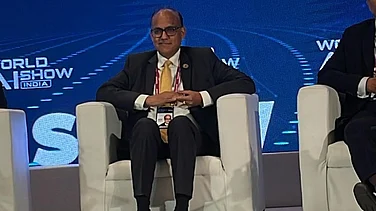At first sight, Ajayagada village's 25-year-old Sarpanch Sulami Sabara is the antonym of anything firebrand. The 12th class pass-out's reticent demeanor can easily pass off for a streak of shyness not uncommon among the women of her tribal clan. At first sight, that is.
But moments into the conversation, one stumbles into a tribal youth who is her own person and is determined to justify the position she occupies. She knows she helms the village panchayat because the position is reserved for women. Yet, she comes across as one with both, her politics and her heart in the right place.
For a start, as one heading a local self-government, this woman Sarpanch has a clearly spelled agenda. Sulami wants to establish 10 toilets for women at public places across all village communities that form the Gram Panchayat of some 3,570 citizens.
But Sulami's view is radical in as much as it is refreshing. “Women in the villages need a toilet. Even the weekly haats (markets) do not have a toilet,” she argues. “Women bathe in common ponds – so they must have some exclusive space to change,” she says, giving a clue of the exposure she has got from studying in the city high school over 50 Km away.
Sitting in the backwoods and unlike the metropolitan cities, Ajayagada is cut off from the rest of the world. Mobile telephony is unlikely to arrive anytime soon. The Ajayagada Grama Panchayat is home to Lanjia Saora, one of India's 75 Particularly Vulnerable Tribal Groups, on the slopes of the Eastern Ghats in Southern Odisha's Gajapati district.
She has brought up the issue of toilets in the Gram Panchayat Development Plan (GPDP). Plans have even been made how the yet-to-come-up toilets will be maintained by the village women's self-help groups. The village's development agenda is a tool for her to help women in the village use their collective women's agency. She is keen to ensure she does justice as the village's woman Sarpanch. Her husband himself is a school dropout and no other member in the Panchayat body matches her education. All of this gives Sulami the audacity to assert herself – a tall order for a Lanjia-Saora woman.
Astute and assertive
Sulami's is the story of the emergence of a young tribal woman from the shadows. Her minimal political education is no stumbling block. She feels that asking her village Gram Sabha to vote for the exclusive toilets for women is a fight for justice and so she visits communities during the village Palli Sabhas (meetings of franchised residents of revenue villages), talking to them about the need to vote for her proposal so that government officials take note and provide funds – this is GPDP at work.
Her ambitious political agenda has been set in the backdrop of her election – her 967 votes to her opponent's 864. Women outnumber men in these villages. The district's gender ratio is 1,024 females for 1,000 males.
Her opponent's husband happened to be the Panchayat mate, a position that entails monitoring
work under the National Rural Employment Guarantee Act (NREGA) scheme. “People in the village thought that my opponent's husband would run the show,” Sulami says of her opponent.
Padmani Mandal, a fellow panchayat member, says, “People knew what they were voting for. Sulami is educated and is socially active. But most importantly, villagers thought Sulami would be her own person while her opponent in the election would be a namesake, handing over the ropes to her husband.”
Cut off by vast stretches of forests and miles away from the madness of cities, the village's idyllic settings offer space for innovations and experimentations that make Panchayati Raj laws spelled out in Parliament 1992 more meaningful by ensuring that the villages' least heard sections have an active role in the institution of self-governance.
Campaign for governance
Women leaders like Sulami are not alone. The People's Rural Education Movement or PREM and the United Nations Population Fund (also known as UNFPA) have teamed up to support local leaders as part of the latter's Pre-election Women Awareness Campaign (PEWAC), an initiative to ensure engendering of democratic and governance institutions.
The two partners mentored the women to become community leaders in a land of inherited biases.

Take, for example, the Badakalakote Gram Panchayat in another part of the district. Its Sarpanch, Subhanita Raita has been going from door-to-door canvassing against men folk battering their wives. “Domestic violence has entrenched itself deeply here,” says Subhanita, explaining how, on more than one occasion, she has stepped in just in time before a woman took her own life.
“The sad part is that women are scared that their spouses will marry a second time and there is little the Gram Panchayat can do on this subject,” she says. "So often, intoxicated husbands return home and turn violent." Subhanita wants to undertake a street campaign against liquor consumption in the tribal village – something that the menfolk around dismiss with a loud laugh.
The effort by women leaders like Subhanita and Sulami is to enable women to come together to bring their common issues to the table. Village corner meetings have had little space for a discourse on subjects concerning women so far, and now women Sarpanchs are trying their best to move gender issues up in the village community discussions.
According to UNFPA's Head of Office in Odisha, Nadeem Noor, “Opening up political and governance platforms and avenues for women will ensure their representation. It will also help bring up issues related to women and yield space for them to voice their concerns."
The PREM-UNFPA partnership fulcrums on ensuring the engendering of democratic and governance institutions even as the PEWAC campaign itself focuses on the initial electoral process to develop and nurture the leadership of women and girls.
In the tribal settings of the Lanjia Saora tribal people, this begins with aiming to get more women to offer their candidature for the Panchayat elections and helping them to file their nomination papers.
PREM's team on the ground helped the women file nomination papers, even assisting them out with the mandatory affidavits, the want for which leads many a nomination application to be rejected. A total of 365 women were supported through nomination-help camps and as a result not a single woman was denied the opportunity to contest the elections for want of a proper set of nomination papers.
Unschooled parents
Together with voter awareness drives reaching some 20,000 voters across the district's various blocks, PREM's staff also held mock election exercises with dummy ballot papers and boxes, telling people in the village how exactly the ballot papers should be marked, folded and inserted into the ballot boxes . Attention was also paid to women, particularly the first-time voters among them. As a result, voting turnout saw a spike.
But this was just part of the course. An electoral discourse on the issues confronting women and girls became a feature village after village as participants endorsed a people's manifesto that the PREM-UNFPA team prepared with the communities. This is a rarity. Even elite urban voters have little say in steering the direction of the electoral discourse.
The UNFPA-PREM partnered campaign is an education in citizenship. For instance, while women leaders are being hand-held, other women are being mentored to keep them on their toes, preparing to constantly hold the new leaders to account. Panchayat standing committees have been strengthened with regular meetings and girls and women are gearing up to monitor development programs and a women's desk in every Panchayat ensures that women are not left voiceless. As part of the campaign, Panchayat members are even going through five days of trainings to become more effective in leveraging the tools of governance.
This means that the new leaders know that they are constantly being watched, making for a radical thought smearing minds across the village – a thought that pivots on a unique social contract innate to their tribal lives.
The Guma block development officer, Anup Avishek Behra, looks at this elaborate civic exercise from the lens of participation. He avers that young people have the advantage of learning much of local self-governance practices through schooling and have the advantage of being more aware than the earlier generations that have been left out.
“Schools are educating children. But many parents were never students. They need a level of education,” he says. “NGOs work at grassroots levels, which is important for grassroots democracy. But the need remains for even more empowerment with knowledge that is reflected in the GPDP process.”
A formalized assembly or Palli Sabha is not part of the discourse process in tribal settings, says Lingraj Panda, Gajapati's district collector. “What we are trying to do is to retrofit a very specific (one-sided, pan-India) solution into a Saora solution,” Panda says, juxtaposing the challenges in introducing a governance model accruing from the Panchayati Raj Act into a tribal community. .
Panda adds that the UNFPA initiative has accelerated the speed of the change process while being sensitive to the values of tribal people. The collector takes pride in the gender-oriented discourse in Gajapati's tribal settings and also refers to another campaign by the district administration targeted at ending girl child marriages.
Education and inspiration
Panchayati Raj is a new introduction to the tribal value system of caring and sharing, says PREM's president, Jacob Thundyil. These values have drawn the framework of traditional tribal governance systems, he says, propelled by a sense of self-dignity. “The earlier generation never participated in the Panchayat; non-tribal people held power in the Panchayats,” he says, underlying the reason behind the challenges of getting communities to participate in Panchayati Raj Institution.
Jacob feels that education is the one tool that the tribal population needs from outside their sphere.
PREM has worked in this direction, considering that it is an investment for life and has educated about 100,000 tribal children. “Today, about 55,000 are employed in different spheres of life. Education is the only tool to empower people.
Sagarika Raika, 22, offers a living example of what tribal people can achieve through education as Jacob stresses. She was in school when her parents attempted to marry her off and her resistance has become an inspiration for others around her. “Child marriage is common here and I argue for letting young girls wait and be fully prepared for a marriage,” she says. An ensuing discussion on child marriage brings out the issue of 'adhikaar' or rights – something villagers could not imagine a generation ago.
Women like Sulami Sabara and Subhanita Raita are not only emerging as changemakers themselves, but are also serving as inspirations for hundreds of other young women.

























